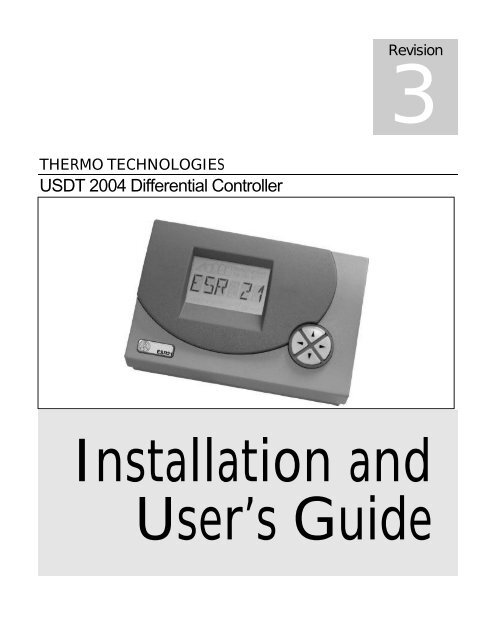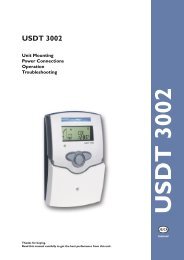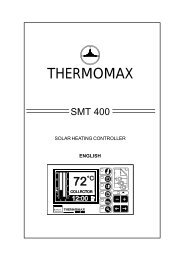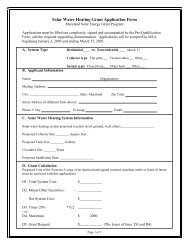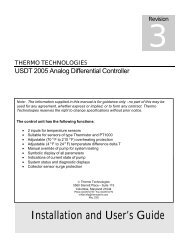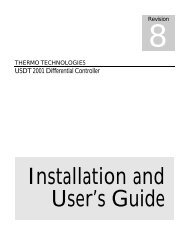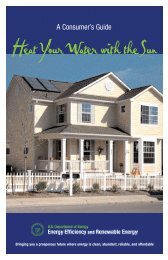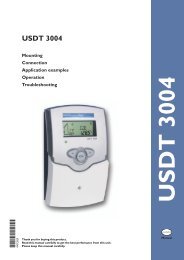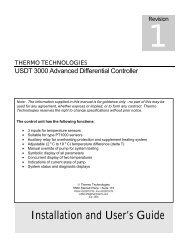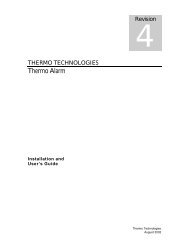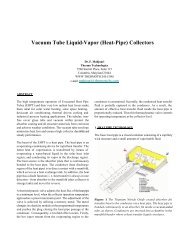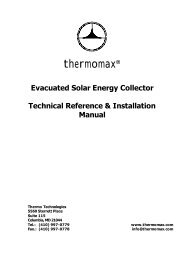USDT 2004 Differential Controller - Thermomax Technologies
USDT 2004 Differential Controller - Thermomax Technologies
USDT 2004 Differential Controller - Thermomax Technologies
Create successful ePaper yourself
Turn your PDF publications into a flip-book with our unique Google optimized e-Paper software.
Revision3THERMO TECHNOLOGIES<strong>USDT</strong> <strong>2004</strong> <strong>Differential</strong> <strong>Controller</strong>Installation andUser’s Guide
<strong>USDT</strong> <strong>2004</strong> DIFFERENTIAL CONTROLLERInstallation and User’s GuideTable of ContentsIntroductionGeneral Information 3Installation 4Collector Sensor 5Control Box 6Power Connection 8Sensor Connection 7OperationControl Mode 10Program Mode 10Advanced Mode 12Alarm Functions and Diagnostics 15Energy Calculations 16© Thermo <strong>Technologies</strong>5560 Sterrett Place • Suite 115Phone 410.997.0778 • Fax 410.997.0779e-Mail info@thermotechs.comJune, <strong>2004</strong>
IntroductionNote: The information supplied in this manual is for guidance only - no part ofthis may be used for any agreement, whether express or implied, or to form anycontract. Thermo <strong>Technologies</strong> reserves the right to change specificationswithout prior notice.T he <strong>USDT</strong> <strong>2004</strong> unit is a powerful temperature differential controller. It canbe used in a wide range of applications. At the factory, it is set to controla simple solar water heating system. In this program mode, PROGRAM 0,<strong>USDT</strong><strong>2004</strong> ensures that the collected energy from the sun is transferredefficiently, and harnessed under optimum conditions. It monitors the collectortemperature (T 1 ) and the return temperature (T 2 , bottom of the storage tank). Thesolar loop circulation pump runs while the collector temperature exceeds thereturn temperature by a programmable temperature difference DELTA T. Toavoid overheating, the circulation pump stops if the collector (T 1 ) temperaturereaches the programmable high limit (T MAX ) temperature. To prevent freezing, thecontroller activates the pump and circulates water through the solar loop whenfrost conditions exist. The temperature hysteresis (a lagging in the set-point) mayover-ride DELTA T and can be modified in advanced operation mode to avoidpump cycling. You may measure the temperature of the storage tank (T 3 , top ofthe tank) using the third sensor in the program mode 1, PROGRAM 1.The control unit has the following functions:• 2 inputs for temperature sensors• 1 input for flow rate measurement or additional temperature sensor• Can be used as BTU meter for constant flow rate or in concert with a flowmeter• Suitable for sensors of type Thermistor and PT1000• All hysteresises are adjustable and depend on temperature• Adjustable (-3 o F to 41 o F) frost protection• Adjustable (200 o F to 299 o F) overheating protection• Adjustable (4.1 o F to 99 o F) temperature difference DELTA T• Manual override of pump for system testing• Digital display of all parameters• Indications of current state of pump• System status and diagnostic displays• Collector sensor surge protection2
General Information:<strong>USDT</strong> <strong>2004</strong>, program mode “0”, is suitable for Closed and Open Loop systems.Closed Loop Solar Heating Systems are the preferred option for extremely coldareas and areas with questionable water quality. The following arrangementshows an application example in a closed loop system.1. Collector 7. Check Valve 13. Pressure Gauge2. Collector Sensor 8. Hose Bibs for Filling and Flushing 14. Collector Supply3. Manual Air Valve 9. Expansion Tank 15. Heat Exchange Coil4. Hot Water to Taps 10. Air Purge and Air Vent 16. Solar Hot Water Tank5. Tempering Valve 11. Circulating Pump with flanges or couplings 17. Immersion Heater6. Collector Return 12. Pressure Relief Valve 18. <strong>USDT</strong> 2001 <strong>Controller</strong>Operation:<strong>USDT</strong> <strong>2004</strong> <strong>Controller</strong> (18) will switch on the pump (11) when the temperatureat the collector sensor (T 1 ) T C is higher than the return temperature (T 2 ) T R by atleast the pre-selected amount ?T. The pump circulates a heat transfer fluidaround the loop. Heat from the collector is transferred to the storage tank throughthe heat exchange coil. With the pump running, if DELTA T is less than presetvalue, the pump will switch off. When a preset collector temperature is reached atT MAX , the controller switches off the pump. The check valve (non-return valve)prevents heat from the tank rising towards the collector, should the tank bewarmer (e.g. at night). Please refer to the operation section of manual.3
INSTALLATIONNote: This installation procedure is for guidance only, and the installer shouldverify its suitability. Make sure that the solar system is physically installed,manually tested, and is ready for controlled operation.T he following safety precautions are strongly recommended:1. Before attempting to install and operate the unit read this instruction manualcarefully.2. Only suitably qualified personnel should carry out installation and anymaintenance required.3. It is recommended that the unit be connected to the power supply via asuitably 6 amps isolating switch.4. WARNING: When the unit is connected to the 115-volt power supply andthe cover is opened, high voltage circuits will be exposed. Therefore,when installing the unit (115-volt model) ensure all required connections aremade and the cover is attached to the controller box before turning the poweron. Ensure that all the connections are secure. If any maintenance work isrequired ensure that the unit is isolated from the power supply beforeremoving the cover. Never leave the unit unattended if the cover hasbeen removed and the power supply is connected.5. Do not exceed unit ratings of 2.15 amps (1/6 HP or 245 Watts pump).6. It is advisable to route power cables away from sensor cables.4
Sensor installation: Temperature sensors may be installed in fluid lines bymounting in a tee or strapping it to the piping directly. For the system tofunction correctly, it is very important that the sensors are located andinstalled properly. Make absolutely sure that they are pushed completely into theoptional sensor pockets (Thermowell is not supplied). Sensors must be wellinsulated in order to prevent them from being influenced by the ambienttemperature.When used outdoors, no water should be allowed to get into the immersionsleeves (lasting impedance change). Generally, sensors should not be exposedto moisture (e.g. condensation) as this can diffuse through the cast resin anddamage the sensor. Heating at approx. 195 °F for one hour may possibly savethe sensor.When sensors are used in open loops or swimming pools, make absolutely surethat immersion sleeves (sensor pockets) are corrosion-resistant.• Collector sensor (cable with protective terminal box): Either push into athermowell (sensor pocket), which is soldered or riveted, directly to the manifold(vacuum tubes). Or strap it to the collector outlet pipe or the absorber (flat platcollectors) that projects from the collector housing. The best practice is theinstallation of a suitable sensor pocket into a T-piece on the collector returnoutlet, to house the collector sensor. Protect sensor cable from UV and moisture.For vacuum tube collectors, use only PT1000 sensors (480 °F max.temperature).• Hot water tank sensor (white cable): In the case of external heatexchangers, the tank sensor should be installed with an immersion sleeve in thereturn leg (cold side) of the heat exchanger. In tanks with integrated heatexchangers, the sensor pocket should be fitted at the exchanger's return outletso that the immersion sleeve goes into the exchanger tube.• Clip-on installation: Best secured to the appropriate line with pipe clamps,clips, etc. whereby you must make sure that the material is suitable (noncorrosive,heat-proof, etc.). It is advisable to insulate the sensor well in order tomeasure the pipe temperature accurately and to prevent any influence fromambient temperature.• Storage tank installation: The sensor required for the solar loop is installedin the lower part of the storage tank. If there is no provision for tank sensor, it isadvisable to push the sensor beneath the insulation – keeping it close to theinner tank wall at the desire tank location.• Pool sensor installation: Place a heat conductive T-piece on the suctionline directly at the pool outlet and screw in the sensor with an immersion sleeve(check corrosion resistance of the material used). Another possibility would be to5
attach the sensor at the same place by means of clips or adhesive tape, usingappropriate thermal insulation against environmental influences.• Sensor cable extension: Sensor cables (22/4 AWG telephone cable) canbe extended up to 150 ft. A connection between the sensor and extension can beestablished as follows:Cut supplied heat shrinkable tubing to desired length (about ½ ”). Slide tubingover one end of wire to be sliced after removing enough outer insulation toaccept the tubing. Then splice wire and slide tubing over the splice. Heat gentlyall around until tubing shrinks tight.Slide larger tubing (about ¾ “) over the entire completed splice. Heat gently allaround until tubing shrinks tight. This connection can then be drawn gently intothe pipe work. You need only two wires for sensor cable; the other two wires arespare wires.Caution: Do not overheat tubing! Remove heat as soon as tubing shrinks tight,as material will continue to shrink. With flame source, use even back and forthmotion all around tubing. A heat gun may be used, if available. Let tubing coolfor maximum strength.C ontroller unit installation: For viewing comfort, the controller unitshould be positioned at eye level. It is always good practice to keepelectronic equipment away from cold, and heat, as extremes of temperature mayreduce the lifetime of the device. It is also good practice to keep electronicequipment away from heavy electrical loads, switches or contactors as thesemay cause electrical and electromagnetic interference when switched on or off.6
Undo the one screw at the top of the housing. The control electronics aremounted on the enclosure cover. Using proper fixing, the controller enclosurecan be screwed to the wall with cable entry grommets downwards. Use thesupplies plastic bridges to secure power and sensor cables.Base of the unit to be mounted at the eye-level and wired as shown aboveCaution: <strong>Controller</strong> wiring should only be done when the unit is not energized. Itis possible to damage the control unit if it is assembled under voltage.7
Miniaturized terminal blocks are used for making wiring connections. The wire isheld in place within the terminal with screw that provides excellent contactwithout damage to the wire.Sensor Cable Connection: Use up to an 18 AWG stranded wire to connect thesensor cables to the unit. The S1 terminal should be connected to the collectorsensor (higher temperature); the S2 terminal is designated for the tank sensor(lower temperature). And the S3 terminal is reserved for the advanced usage ofthe unit such as third temperature sensor (in program mode 1), flow meter, lowinsolation start, or second tank temperature monitoring in other programmingmodes.P ower Connections: A small blade screwdriver may be used to fastenminiaturized terminal block screws while the corresponding wire isinserted.NOTE 1: Always disconnect the controller from power supply beforeopening the housing.NOTE 2: The controller should be properly grounded. Flexible wires, 18/3 AWG(gauge/conductor) simplify connection to the terminals. The power terminalblock will accommodate wi re sizes to 14 AWG. All other connections should besecured and adequately tightened, as loose power connections will over-heat,and may cause fire.NOTE 3: It is important that the specified output loads (245 Watts) are notexceeded. Where these loads expect to exceed, external relays must be used. Itis good practice to install a 3 amps in-line fuse to protect controller and pump.Always keep power cables away from sensor cables and other low voltage signalcables.NOTE 4: To protect against lightning damage, the system must be groundedaccording local regulation. Sensor failures due to the weather or electrostatic aremostly due to poor grounding.NOTE 5: If step-down transformer is not mounted on the circuit board, the unitshould be powered by a 24 VDC. A step-down transformer can be used alsoinstead of DC power source; however, the open circuit voltage of the AC sourcemust be below 24 VAC.8
Your controller displays requested information one at a time. The unitdisplay window has three lines to inform user about the system status,unit of displayed parameter and its value.Upper Line Symbolic display of sensor location, reading unit, and operationdomainCenter Line Sensor ID and its reading in normal mode (user interface window)Lower Line Set-point indicator that illuminates only during programming modeð Push selection key once to move to the next selection; or increase theselected parameter by one unit.ï Push selection key once to move to the previous selection; or decreasethe selected parameter by one unit.ò Push selection key once to enter the advanced mode. Once in advancedmode, press one more time to select the parameter. Selected parameterblinks allowing the user to modify it. You can modify the selectedparameter while the middle window blinks by pressing the ï or ð key.ñ Push selection key once to accept selection (blinking stops showing thenew set-point steady) or go back to the previous selection.Use selection keys ïð during normal system operation to display the desiredparameter:T1 Collector temperature in o FT2 Tank temperature in o FT3 Reading of the third sensor; if the third sensor is not used itdisplays a fixed reference temperature of 250 o FOK System is running normalXX Collector power in [kW]YY Energy collected in [MWh]ZZ Energy collected in [kWh]GAL Flow rate [gallon/h]9
Operation Mode – Displays temperatures and collected energyPressing the selection key ð four times displays the unit statusStatus Mode – Displays selected parameter and its valuePressing the selection key ð five times allows you to enter into the programmode (Par). Push selection key ò once to enter the program mode.Program Mode – Using the navigation key ^_ allows you to select the desiredparameter while you are in the program mode. Press the selection key ò once toselected the parameter in the window. Selected parameter blinks allowing you tomodify it. You can modify the selected parameter while the middle window blinksby pressing the ï or ð key. The unit accepts the new value by pressing the ñkey once. To avoid unintentional set-point changes, the user must enter theaccess code “32” to manipulate factory settings.10
RUV X.X – This display shows the software revision number. (DV units areloaded with variable speed drive.)NR O - Indicates simple operation of unit as a Universal Solar <strong>Differential</strong>Temperature (<strong>USDT</strong>) controller. You may move to next level of sophistication byregistering your unit and having an authorization code. Change this value to 1 foractivation of third sensor.Hysteresis Bandwidth – User can program hysteresis (temperature range foroutput control) by using max?, max=, min=, and min?.max?1 Pump stops above this temperature (T1, T2, T3)max=1 Pump runs below this temperature if other conditions aremet (T1, T2, T3)Note: This feature is useful to protect over heating of storage tank (T2) and inother program version not supported with basic software load.diff=1diff?1Pump runs when temperature difference between collectorT1 (collector) and T2 (tank) exceeds this value. Factorysetting is 15 o F. Consult your collector manufacturer for therecommended value.Pump stops when temperature difference between collectorT1 (collector) and T2 (tank) reaches this value. Factorysetting is 7 o F. Consult your collector manufacturer for therecommended value.11
AUTO – The last display of the above example indicates that the unit is workingin automatic mode. The pump starts at a temperature difference of 15 o F andruns as long as ? T is above 7 o F. The B symbol appears in upper display linenext to the collector symbol while the pump is running. User can switch tomanual mode by pressing ò key. By pressing ð key while centerline blinks, ahand symbol G in lower line shows manual operation. Pressing ð one more timelets you turn the pump ON or OFF. By pressing ñ key you change the pumpoperation.Advanced Mode “Men” – <strong>USDT</strong> <strong>2004</strong> is extremely powerful. It can be used inwide range of applications such as a BTU meter, a boiler fuel optimizer, aswimming pool temperature differential controller, a variable speed controller, agreenhouse temperature regulator, an air handler, and more. Factory settings areexclusively for solar water heating systems in the USA market. However, all itsparameters can be changed to meet the unique requirements of otherapplications. The user may request an access code to modify the <strong>USDT</strong> <strong>2004</strong>program mode and its parameters. To get your unique access code, pleaseregister your unit at:Solar@ThermoTechs.comWe need the serial number of your <strong>USDT</strong> <strong>2004</strong> and your e-mail address to e-mailyour access code.The factory setting will be retrieved by pressing and holding ò key duringpowering of the unit. A “RESTOR” displays for three seconds while factorysettings are restored.Advanced Mode can be accessed only with an authorized access code.Selection of different sensor types, energy collection calculationparameters, system protection and optimization can be can be modified inadvanced mode.Navigation of advanced features of the unit and selection of parameters is thesame as before by using ïòñð keys:Advancing – Press the Advance key ïð briefly to advance to the next selectionor to increase/decrease the set-point of the selected parameter. Hold it down forfast change.Acceptance – Press Set-Up key ò once to select the parameter. Press ñ key toaccept the selection or the set point.12
ModeSENSORSGUARDSTARTALARMBTUOperationSelects sensor typeProtects system from overheating and frostStarts pump at pre-set insolation (solar radiation intensity)Enables/Disables protection functionsEnergy calculation and settingSensor Selection – <strong>USDT</strong> <strong>2004</strong> accepts different sensors types. User canprogram a constant temperature instead of a sensor output also. Thesensor types are programmed at the factory for thermistor (KTY 10) types. ThePT 1000 sensor is recommended for high performance collectors such as<strong>Thermomax</strong> systems and will not be damaged during collector stagnation. PT1000 works fine in 482 o F range and survives up to 572 o F temperatures for ashort period of time. The KTY 10 tank sensor should be used in a conditionedenvironment and will not be permanently damaged up to 360 o F.Selection:S1S2S3Sensor 1 (collector outlet) selectionSensor 2 (collector inlet) selectionSensor 3 (tank) selectionDesignation:PT PT 1000 sensor (1000 O at 0 o C)KTY Thermistor sensor (2000 O at 25 o C)250 250 o F reference temperature- 4 - 4 o F reference temperature13
Sensor wires can receive electromagnetic pulses, which can result in a wrongtemperature reading. The <strong>USDT</strong> <strong>2004</strong> reads sensor values every 50 ms. It canbundle several readings and process their average.AV 1 Sensor 1 averageAV 2 Sensor 2 averageAV 3 Sensor 3 averageThe numbers of samples can be programmed from 4 to 20.F rost and overheating protections - Pump operation can be manipulatedby the user in both collector stagnation and frost conditions. The set-up ispossible in System Guard, SGUARD, domain.Overheating protection – The Circulation pump may not be powerful enough tocirculate the heat transfer fluid in the solar loop with air pockets. User canprogram the pump to stop at a desired maximum temperature, shown by ?symbol, to protect the pump. The <strong>USDT</strong> <strong>2004</strong> will take over the normal operationafter the temperature decreases to an acceptable working temperature, shownas =. This feature is disabled at 299 o F set point.Frost Protection – Frost protection in the sun-belt region is provided bycirculating water in the solar loop when freezing conditions exist. Regardless ofthe temperature difference Delta T, the circulation pump runs when the collectortemperature is below a programmable minimum temperature, shown by =symbol. The pump stops as soon as the temperature in the solar loop reaches asafe region programmed by the ? symbol. This feature is also disabled at thefactory by entering - 4 o F.min= Pump runs below this temperaturemin? Pump stops above this temperatureS tart functions - The Circulation pump can be programmed to start on lowinsolation level. The Start function feature is useful when heat transferredto the collector sensor is not fast enough for early start; especially when thecollectors are flat mounted.The enabled start function runs the pump at a given solar radiation orprogrammed temperature difference. The feature is disabled at the factory.14
STARTENABLDISABStart function screenEnable start functionDisable start functionIf this feature is selected, following parameters must be adjusted for properoperation:SENS Pyranometer port designation (radiation monitoring sensor port)1 Sensor 12 Sensor 23 Sensor 3-- Manual input in next stepINS Radiation threshold in W/m 2CIRC Pump runtime in secondsINT Maximum interval time in secondFLU Number of flushesThe following example activates the circulation pump at 200 W/m 2 and runs it for15 seconds. If rT condition is met within the time period, the pump stays on.INS 20CIRC 15Alarm functions - User can enable the alarm function of the <strong>USDT</strong> <strong>2004</strong>in the ALARM screen. Status of sensors and circulation pump can beviewed if alarm function is active.A ONA OFFAlarm function enableAlarm function disableThe status of the system can be monitored in the Stat Mode only if thecorresponding feature is active. The following example shows a system conditionwith a circulation problem:OT OFF Overheating feature disableOT OK No overheating1 SHORT Short circuit in sensor 1 wiring2 SHORT Short circuit in sensor 2 wiring1 OPEN Disconnection in sensor 1 wiring2 OPEN Disconnection in sensor 2 wiringOK System operates normalNO CIRC r T is more than 108 o F in last 30 minutesOK CIRC Pump is running15
CLEARClears NO CIRC display after correctionE nergy calculation - Energy gain is calculated by obtaining thetemperature increase of heat transfer fluid across the solar collector. The amountof fluid flow through the collector is registered by an in-line flow meter. <strong>USDT</strong><strong>2004</strong> computes the energy production as a function of the temperaturedifferential and fluid volume. In addition, the system anti-freeze (Glycol)percentage should be entered as it affects the thermal conductivity and heattransfer rate.BTU Energy calculation modeS IN Sensor port selection for inlet temperature (1, 2, 3, --)S OUT outlet temperature (1, 2, 3, --)F SEN Sensor port selection for flow rate (1, 2, 3, --)Energy calculation will be initiated only after temperature sensor ports aredesignated. Flow rate can be either a constant number to be entered by user, orfrom a flow meter input. To activate the energy calculation without using the flowmeter's impulse input, a dash (-) must be selected for F SEN channel followed bythe constant flow rate in gph (gallon per hour) unit.LLP Flow meter rate impulse number in liter per pulse, if flow meter isusedGAL Constant flow rate in gph instead of flow meter reading in (--)sensor modeGLYCOL Anti-freeze percentageCLEAR Sets the BTU meter's counter to zeroDIF Sensor calibrationThe output of <strong>USDT</strong> <strong>2004</strong> unit is kW for system power and kWh or MWh forcollected energy.The energy calculation dependents on flow meter accuracy, the temperaturesensors class, and their locations. The flow meter is a mechanical device and itsaccuracy fluctuates over time. Therefore, the user should calibrate the flow meterand incorporate temperature sensor tolerance.The supplied Thermistor sensor has an accuracy of ± 2 o F. The PT1000 sensoroffers a better accuracy of ± 1 o F. DIF represents the temperature differencebetween two sensors. User can increase the accuracy of reading by adjusting theDIF parameter. The energy calculation becomes accurate at temperature rangethat this reading adjustment is made.16


